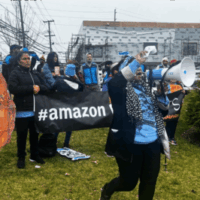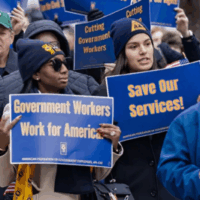Washington, DC – Following is a statement from Rebecca Dixon, president and CEO of the National Employment Law Project, on the Occupational Safety and Health Administration’s final rule on the worker walkaround representative designation process:
“NELP commends OSHA on its swift publication of a final rule laying out the legal standard for designating a worker representative to accompany OSHA inspectors on a worksite walkaround. The new rule, released today for publication Monday, will better enable workers to select representatives of their choice to accompany the OSHA Compliance Safety and Health Officer (“CSHO”) on worksite inspections. Under the rule, the representatives need not be employees at that worksite, but could be a trusted third-party, like a worker center or community advocate.
“Many workers will now have the benefit of third-party representation during worksite walkaround inspections, as long as ‘good cause has been shown why accompaniment by a third party is reasonably necessary to the conduct of an effective and thorough physical inspection of the workplace.’ This regulatory change will ensure that OSHA is better able to obtain critical information about worksite conditions and hazards, keeping workplaces across the country safer.
“Because of occupational segregation, Black and Latinx immigrant workers have historically been funneled into occupations with poor working conditions and continue to encounter higher injury, illnesses, and fatality rates. For workers in these dangerous and low-paying industries—warehousing and manufacturing, meatpacking and poultry-processing, and agriculture—where the workforce consists overwhelmingly of immigrant non-English speakers, walkaround representation is critically important. Where workers struggle to communicate effectively with a CSHO investigating the worksite, or where they are reluctant to speak out for fear of retaliation, OSHA’s enforcement suffers.
“But workers who are represented by a trusted community partner—like a worker center with language skills, cultural competency, and a detailed knowledge of safety conditions in that industry or worksite—are likely to feel protected and empowered to speak up.
“Prior OSHA regulations had allowed workers to obtain non-employee walkaround representation only in certain circumstances and on a case-by-case basis. For example, OSHA had allowed health and safety professionals, like industrial hygienists and safety engineers, as well as union representatives on unionized worksites.
“But today’s rule expands the universe of possible third-party representatives beyond professionals with technical expertise, shifting the focus from professional discipline to the ‘knowledge, skills, and experience’ that workers and their chosen representative may bring to the walkaround inspection. It offers better opportunities for workers in unorganized workplaces to get a walkaround representative of their choosing. While professional health and safety experts clearly have an important role to play in worksite inspections, so do interpreters, community advocates, worker center organizers, and lawyers.
“With this rule, OSHA has taken an important step toward improving worksite health and safety enforcement in unorganized workplaces, and to building trust with underpaid, often immigrant workers, doing dangerous but essential work across the country.”
Related to
The Latest News
All newsMayor Bowser & D.C. Council Must Respect the Will of D.C. Voters by Rejecting Repeal of Initiative 82

Blog
New Brief Sheds Light on the Amazon’s Dangerous ‘Flex’ Labor Model

News Release
NELP Denounces Supreme Court Ruling Permitting Immediate Layoffs of Hundreds of Thousands of Federal Workers

News Release
